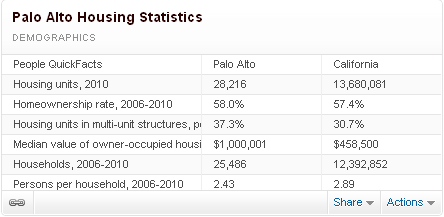Open Data Isn’t Just For Mega Cities: The City Of Palo Alto Proves That
 Many of the marque open data programs are in the big cities. Think New York City and its NY Big Apps Contests, or Chicago or London or Barcelona or Rio de Janeiro. But smaller cities are also sitting on public data. They receive requests for information from their constituents, and their constituents expect new applications and services. Not to mention the fact that cities of all sizes are responding to pressure for greater openness and transparency. These are a few of the reasons why the City of Palo Alto recently launched its open data community site. According to Jonathan Reichtenthal, the CIO of Palo Alto, “It is more common that information is public than not.” And, therefore, why not make it easier for citizens to access?
Many of the marque open data programs are in the big cities. Think New York City and its NY Big Apps Contests, or Chicago or London or Barcelona or Rio de Janeiro. But smaller cities are also sitting on public data. They receive requests for information from their constituents, and their constituents expect new applications and services. Not to mention the fact that cities of all sizes are responding to pressure for greater openness and transparency. These are a few of the reasons why the City of Palo Alto recently launched its open data community site. According to Jonathan Reichtenthal, the CIO of Palo Alto, “It is more common that information is public than not.” And, therefore, why not make it easier for citizens to access?
Palo Alto – with a population of about 65,000, located between San Francisco and San Jose, California, and known as the home of Stanford University and the “birthplace of the Silicon Valley” – was a prosperous, tech-savvy city. But from an IT perspective, the city administration had been working in the past… until about eight months ago when a new CIO came on board. Jonathan Reichtenthal is the “first cabinet-level CIO” of Palo Alto. IT had historically been an administrative division housed with legal, HR, and finance. When the previous head of IT retired, the city manager decided to elevate the status of IT and drive more strategic use of technology within the organization. One of the first initiatives launched by Reichtenthal was open data.
Interestingly, it was a physical infrastructure upgrade, in part, that sparked the new data program. In order to prioritize the physical improvements needed, an outside engineering firm rated the condition of each city street. As citizens learned of the ratings, they requested the information: What is the condition of my street relative to others? One way of responding to the requests would have been to provide the information by pulling the data and sending a spreadsheet to the requester. However, proximity to Stanford gave the city another alternative. During a Stanford-sponsored hack-a-thon, the city made the street rating data available, and one of the students developed Street Viewer, an application showing the condition of Palo Alto streets on the map. That exercise brought home the value of citizen sourcing and spurred the launch of the new open data initiative.
On August 1, Palo Alto’s open data site went live with the following data sets:
- Pavement condition ratings
- City tree locations
- Park locations
- Bicycle paths and hiking trails
- Creek water levels
- Rainfall and tides
- Basic utility-approved data
- 2010 census data for Palo Alto
Palo Alto launched looks forward to the following benefits of their new program:
- Improved perception of the city. Open data counters potential criticism that the city is being secretive. Palo Alto wants to be transparent and open.
- Improved cost-efficiency of responding to public record requests. Palo Alto receives a high number of California public record requests. Each request is assigned to IT staff and the data set is built, all at a significant cost to the city.
- Ability to citizen-source new city services. Recognizing the vast pool of tech-savvy residents, the city saw the value of citizen-sourcing new applications and services.
- Extending the eyes and ears of the city. Having a very well-educated population also allows the city to rely on its citizens to look for patterns in the data and report back to the city. “They will catch things that we don’t.”
Despite expected benefits, there were challenges. For one, data comes from city departments that can be reluctant to participate. However, as Palo Alto experienced, executive support is critical. If the city manager and city council members are onboard, departmental support is more likely to follow. Of course, there are concerns from the legal department, but they are “paid to worry.” Last but not least, the budget is another challenge. In the case of Palo Alto, the city needed a vendor with a pay-as-you-grow model and found that in Junar, a cloud-based open data platform provider. With its tiered purchase plans starting at under $5,000 – often a budget approval threshold for city governments – Junar makes it easy for smaller cities to innovate with open data.
Palo Alto sees open data as a “natural complement to our goal of becoming a leading digital city” and certainly doesn’t see its own size as a disadvantage.